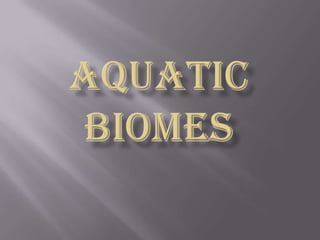
Libunao, christine jamille
- 2. The aquatic biome is definitely the largest biome out there. Water covers nearly 75 percent of the earth's surface, in the form of ocean, lakes,rivers, etc.
- 3. Fresh water regions Marine water regions
- 4. Fresh water regions is defined as having a low salt concentration—usually less than 1%.
- 5. Marine water regions is the biggest biome in the world.
- 6. Lentic -still water Lotic - running water
- 7. Ponds and Lakes Streams and Rivers Wetlands
- 8. Ponds and Lakes Ponds are often seasonal, meaning they created in the rainy season. Lakes will often survived for hundreds of years.
- 9. Littoralzone Limnetic zone Profundal zone Benthic zone
- 10. Littoral zone which closest to the shore is a host to a wide variety of species due to to its warm, shallow environment.
- 11. Limnetic zone the near-surface open water surrounded by the littoral zone.
- 12. Profundal zone is the deeper region of ponds or lakes.
- 13. Benthic zone very bottom of the floor.
- 14. These are bodies of flowing water moving in one direction. Streams and rivers can be found everywhere—they get their starts at headwaters, which may be springs, snowmelt or even lakes.
- 15. Wetlands are area of standing water that support aquatic plants.
- 18. Benthos Plants such as kelp and animals such as brittle fish that live on or depend on the bottom
- 19. Nekton swimming animals such as fishes and whales that moves independ ently of water currents.
- 20. Plankton are very small organisms that live in the world's oceans.
- 21. Ocean Coral Reefs Estuaries
- 22. Ocean represents the largest and most diverse of the ecosystem.
- 23. Inter-tidal -the ocean connects to the land Pelagic zone -out in the open ocean which is host to many species of fish and marine mammals. Benthic zone -or deep sea, and is host to silt sand and slowly decomposing organisms. Abyssal zone -deepest part of the ocean.
- 24. Coral reefs are underwater structures made from calcium carbonate secreted by corals.
- 25. Estuaries is a partly enclosed coastal body of brackish water with one or more rivers or streams flowing into it, and with a free connection to the open sea.
- 26. Prepared by: Christine Jamille O. Libunao BEED -3B